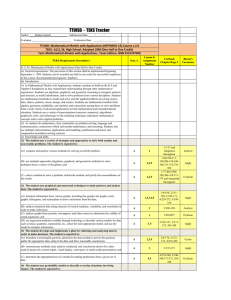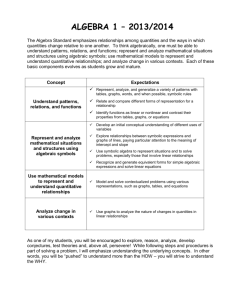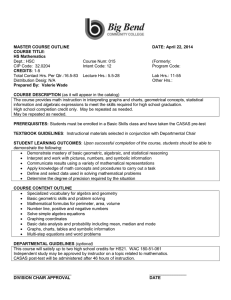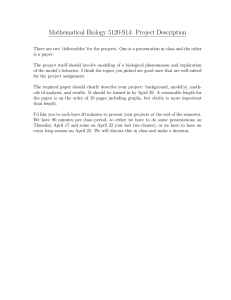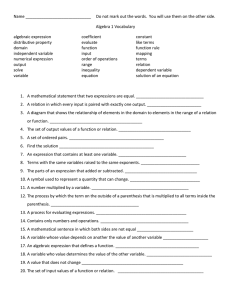Author ____Robin Cottrell________ ... Evaluator______________________________ Evaluation Date _____/______/_____
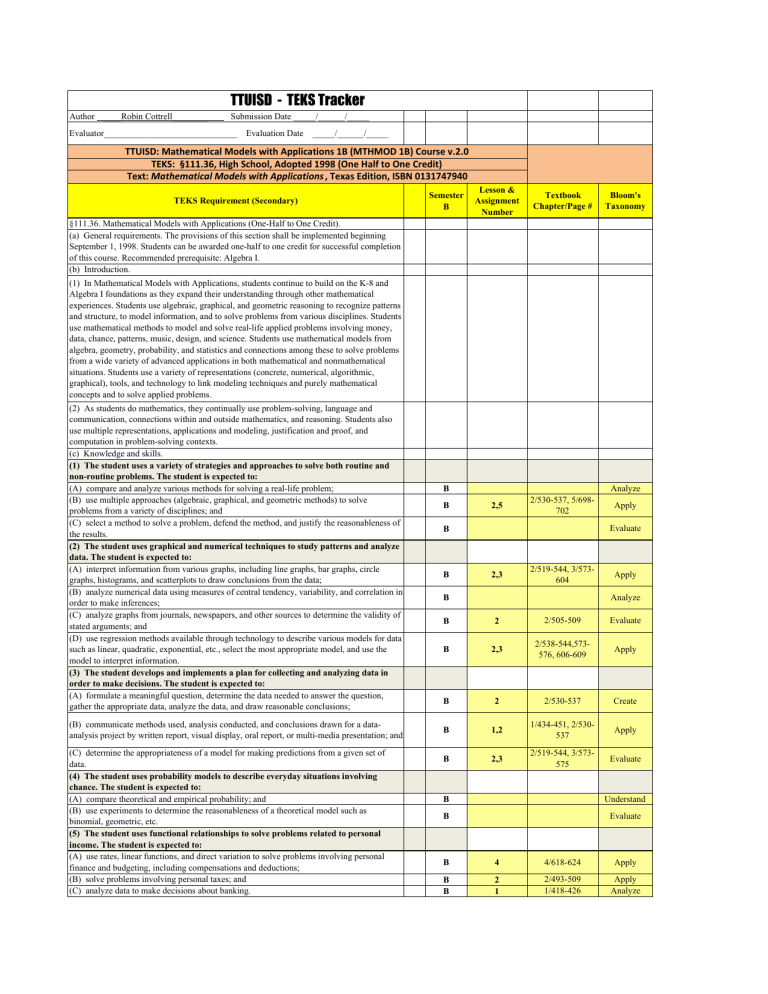
TTUISD - TEKS Tracker
Author ____Robin Cottrell________ Submission Date _____/______/_____
Evaluator______________________________ Evaluation Date _____/______/_____
TTUISD:
Mathematical
Models
with
Applications
1B
(MTHMOD
1B)
Course
v.2.0
TEKS:
§111.36,
High
School,
Adopted
1998
(One
Half
to
One
Credit)
Text:
Mathematical
Models
with
Applications ,
Texas
Edition,
ISBN
0131747940
TEKS Requirement (Secondary)
Semester
B
Lesson &
Assignment
Number
§111.36. Mathematical Models with Applications (One-Half to One Credit).
(a) General requirements. The provisions of this section shall be implemented beginning
September 1, 1998. Students can be awarded one-half to one credit for successful completion of this course. Recommended prerequisite: Algebra I.
(b) Introduction.
(1) In Mathematical Models with Applications, students continue to build on the K-8 and
Algebra I foundations as they expand their understanding through other mathematical experiences. Students use algebraic, graphical, and geometric reasoning to recognize patterns and structure, to model information, and to solve problems from various disciplines. Students use mathematical methods to model and solve real-life applied problems involving money, data, chance, patterns, music, design, and science. Students use mathematical models from algebra, geometry, probability, and statistics and connections among these to solve problems from a wide variety of advanced applications in both mathematical and nonmathematical situations. Students use a variety of representations (concrete, numerical, algorithmic, graphical), tools, and technology to link modeling techniques and purely mathematical concepts and to solve applied problems.
(2) As students do mathematics, they continually use problem-solving, language and communication, connections within and outside mathematics, and reasoning. Students also use multiple representations, applications and modeling, justification and proof, and computation in problem-solving contexts.
(c) Knowledge and skills.
(1) The student uses a variety of strategies and approaches to solve both routine and non-routine problems. The student is expected to:
(A) compare and analyze various methods for solving a real-life problem;
(B) use multiple approaches (algebraic, graphical, and geometric methods) to solve problems from a variety of disciplines; and
(C) select a method to solve a problem, defend the method, and justify the reasonableness of the results.
(2) The student uses graphical and numerical techniques to study patterns and analyze data. The student is expected to:
(A) interpret information from various graphs, including line graphs, bar graphs, circle graphs, histograms, and scatterplots to draw conclusions from the data;
(B) analyze numerical data using measures of central tendency, variability, and correlation in order to make inferences;
(C) analyze graphs from journals, newspapers, and other sources to determine the validity of stated arguments; and
(D) use regression methods available through technology to describe various models for data such as linear, quadratic, exponential, etc., select the most appropriate model, and use the model to interpret information.
(3) The student develops and implements a plan for collecting and analyzing data in order to make decisions. The student is expected to:
(A) formulate a meaningful question, determine the data needed to answer the question, gather the appropriate data, analyze the data, and draw reasonable conclusions;
(B) communicate methods used, analysis conducted, and conclusions drawn for a dataanalysis project by written report, visual display, oral report, or multi-media presentation; and
(C) determine the appropriateness of a model for making predictions from a given set of data.
(4) The student uses probability models to describe everyday situations involving chance. The student is expected to:
(A) compare theoretical and empirical probability; and
(B) use experiments to determine the reasonableness of a theoretical model such as binomial, geometric, etc.
(5) The student uses functional relationships to solve problems related to personal income. The student is expected to:
(A) use rates, linear functions, and direct variation to solve problems involving personal finance and budgeting, including compensations and deductions;
(B) solve problems involving personal taxes; and
(C) analyze data to make decisions about banking.
B
B
B
B
B
B
B
B
B
B
B
B
B
B
B 2,5
2,3
2
2,3
2
1,2
2,3
4
2
1
Textbook
Chapter/Page #
2/530-537, 5/698-
702
2/519-544, 3/573-
604
2/505-509
2/538-544,573-
576, 606-609
2/530-537
1/434-451, 2/530-
537
2/519-544, 3/573-
575
4/618-624
2/493-509
1/418-426
Bloom's
Taxonomy
Analyze
Apply
Evaluate
Apply
Analyze
Evaluate
Apply
Create
Apply
Evaluate
Understand
Evaluate
Apply
Apply
Analyze
TEKS Requirement (Secondary)
(6) The student uses algebraic formulas, graphs, and amortization models to solve problems involving credit. The student is expected to:
(A) analyze methods of payment available in retail purchasing and compare relative advantages and disadvantages of each option;
(B) use amortization models to investigate home financing and compare buying and renting a home; and
(C) use amortization models to investigate automobile financing and compare buying and leasing a vehicle.
(7) The student uses algebraic formulas, numerical techniques, and graphs to solve problems related to financial planning. The student is expected to:
(A) analyze types of savings options involving simple and compound interest and compare relative advantages of these options;
(B) analyze and compare coverage options and rates in insurance; and
(C) investigate and compare investment options including stocks, bonds, annuities, and retirement plans.
(8) The student uses algebraic and geometric models to describe situations and solve problems. The student is expected to:
(A) use geometric models available through technology to model growth and decay in areas such as population, biology, and ecology;
(B) use trigonometric ratios and functions available through technology to calculate distances and model periodic motion; and
(C) use direct and inverse variation to describe physical laws such as Hook's, Newton's, and
Boyle's laws.
(9) The student uses algebraic and geometric models to represent patterns and structures. The student is expected to:
(A) use geometric transformations, symmetry, and perspective drawings to describe mathematical patterns and structure in art and architecture; and
(B) use geometric transformations, proportions, and periodic motion to describe mathematical patterns and structure in music.
Source: The provisions of this §111.36 adopted to be effective September 1, 1998, 22
TexReg 7623.
Semester
B
Lesson &
Assignment
Number
Textbook
Chapter/Page #
Bloom's
Taxonomy
B
B
B
B
B
B
B
B
B
B
B
1
1
1
1
1
1
2
3
4
5
3
1/434-451
1/452-460
1/434-451
1/418-433
1/461-467
1/418-433, 468-
476
2/510-544
3/553-576, 588-
594
4/618-645
5/703-730
3/605-609
Evaluate
Evaluate
Evaluate
Evaluate
Evaluate
Evaluate
Apply
Apply
Apply
Apply
Apply
